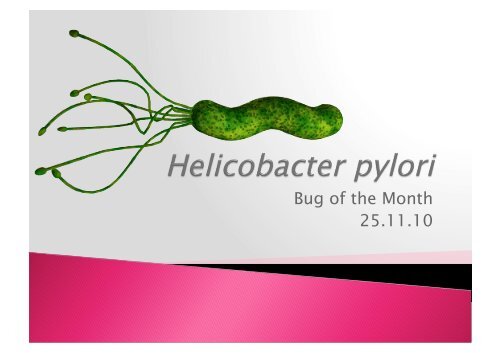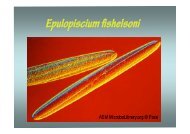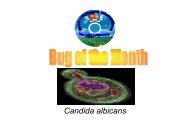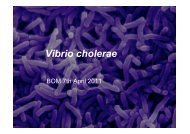Helicobacter pylori.pdf - Academic lab pages - School of Biosciences
Helicobacter pylori.pdf - Academic lab pages - School of Biosciences
Helicobacter pylori.pdf - Academic lab pages - School of Biosciences
Create successful ePaper yourself
Turn your PDF publications into a flip-book with our unique Google optimized e-Paper software.
Bug <strong>of</strong> the Month<br />
25.11.10
Discovered in 1983 (Nobel prize awarded in 2005)<br />
<br />
<br />
<br />
<br />
<br />
<br />
Gram negative, spiral shaped bacterium<br />
Member <strong>of</strong> the gamma proteobacteria<br />
Microaerophilic<br />
Infects ~50% <strong>of</strong> the human population worldwide<br />
One <strong>of</strong> the most common infections in man<br />
More common in less affluent regions <strong>of</strong> the world
Lives in the human stomach and duodenum<br />
Able to survive the acidic conditions <strong>of</strong> the stomach by living in the<br />
mucus lining (this also confers protection against the immune<br />
system) and by converting the host’s urea into bicarbonate and<br />
ammonia using a urease enzyme<br />
Extracellular infection<br />
Tends to cluster around cell junctions to allow urea to<br />
Diffuse and to allow them to get nutrients
Asymptomatic in many people<br />
Can lay dormant for many years<br />
Causes chronic, multi-stage infection:<br />
Gastritis – can occur after weeks/months or after decades<br />
Peptic ulcers - caused by inflammation <strong>of</strong> the stomach lining<br />
Stomach cancer – usually presents after years/decades
Biopsy (endoscopy) –eg –urease test<br />
Breath tests – isotopically <strong>lab</strong>elled urea is swallowed - measure<br />
<strong>lab</strong>elled CO2 when its exhaled<br />
Serology – take blood samples and do ELISA using specific<br />
antibodies
Elimination from the stomach cures symptoms<br />
Triple therapy developed 1 st – metronidazole, ampicillin and bismuth<br />
salts<br />
Double therapy came later (1990’s)-amoxycillin and omeprazole<br />
Ethical issue: Do we treat asymptomatic people –may have benefits<br />
in earlier in life (may stop other pathogens taking a hold by<br />
modifying the host environment)
Flagella: used for motility – allows it to move through mucus. If you<br />
knockout flagella, you get decreased virulence<br />
Toxins : Vac A causes cytoplasmic vacuolation . Exact role is still<br />
unclear (possible epithelial cell damage?)<br />
LPS<br />
Adhesins : e.g. HpaA and BabA – allows it to stick to the host cells<br />
Urease – neutralises stomach acid (protection) and produces<br />
ammonia (damage). Urease mutants have decreased virulence.<br />
Cag pathogenicity island<br />
CagA protein – type 4 secretion pathway virulence effector
Eppinger et al (2006)<br />
Humans have been colonised by H.<strong>pylori</strong> for at least 60,000 years<br />
Evolutionary scientists have used H.<strong>pylori</strong> to track out <strong>of</strong> Africa<br />
migration<br />
Neighbour-joining trees show that there is less diversity in European<br />
strains than African strains.<br />
The African strain is more closely related to the big-cat strain<br />
H.acinonychis Sheeba than the European strain is ... Did big cats<br />
catch H.<strong>pylori</strong> from eating humans???<br />
Atherton and Blaser (2009)<br />
Since the out <strong>of</strong> Africa migration, it has been a part <strong>of</strong> the natural<br />
micr<strong>of</strong>lora <strong>of</strong> humans<br />
Modifies the host immune system long term and affects acid<br />
homeostastis<br />
Now, H.<strong>pylori</strong> is decreasing in prevalence due to improved living<br />
conditions<br />
Other diseases have emerged instead: gastroesophageal reflux<br />
disease, obesity, type 2 diabetes, allergies<br />
Is this disappearance and emergence linked?
<strong>Helicobacter</strong> <strong>pylori</strong> has been a part <strong>of</strong> the human micr<strong>of</strong>lora<br />
throughout our history<br />
It can cause disease, particularly in later life and has a host <strong>of</strong><br />
virulence factors to help it do this<br />
However, it can lay latent in hosts for decades without causing any<br />
problems and may even confer health benefits ...<br />
<br />
Nasty pathogen ... Or cute and cuddly bug?!?





